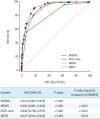A combination of the Modified Early Warning Score and the Korean Triage and Acuity Scale as a triage tool in patients with infection
- PMID: 36588422
- PMCID: PMC10090726
- DOI: 10.15441/ceem.22.339
A combination of the Modified Early Warning Score and the Korean Triage and Acuity Scale as a triage tool in patients with infection
Abstract
Objective: We evaluated the utility of the Korean Modified Early Warning Score (KMEWS), which combines the Modified Early Warning Score (MEWS) and the Korean Triage and Acuity Scale (KTAS), as a triage tool to screen for infection in patients who visit the emergency department.
Methods: We retrospectively reviewed data extracted from electronic medical records. Patients aged ≥18 years with an infection who were admitted to the hospital via the emergency department between January 2018 and December 2019 were eligible for inclusion. The KMEWS score was calculated as the sum of the KTAS level and the MEWS score. We generated receiver operating characteristic curves and determined the area under the receiver operating characteristic curve (AUC) for the KMEWS, KTAS, MEWS, and Mortality in Emergency Department Sepsis (MEDS) scales. The primary outcome was septic shock, and secondary outcomes were intensive care unit admission and in-hospital mortality.
Results: The AUC values (95% confidence interval) for predicting septic shock were as follows: KMEWS, 0.910 (0.902-0.918); MEWS, 0.896 (0.887-0.904); KTAS score, 0.809 (0.798-0.819); and MEDS, 0.927 (0.919-0.934). The AUC values (95% confidence interval) for predicting in-hospital mortality were as follows: KMEWS, 0.752 (0.740-0.764); MEWS, 0.717 (0.704-0.729); KTAS score, 0.764 (0.752-0.776); and MEDS, 0.844 (0.834-0.854). The AUC values (95% confidence interval) for predicting intensive care unit admission were as follows: KMEWS, 0.826 (0.816-0.837); MEWS, 0.782 (0.770-0.793); KTAS score, 0.821 (0.810-0.831); and MEDS, 0.839 (0.829-0.849).
Conclusion: The KMEWS, which is a combination of the MEWS and the KTAS scores, might be a useful triage tool in emergency department patients who present with infection, particularly for predicting septic shock.
Keywords: Critical care; Hospital emergency service; Mortality; Septic shock; Triage.
Conflict of interest statement
No potential conflict of interest relevant to this article was reported.
Figures




Similar articles
-
Validation of the Korean Version of the Clinical Frailty Scale-Adjusted Korean Triage and Acuity Scale for Older Patients in the Emergency Department.Medicina (Kaunas). 2024 Jun 8;60(6):955. doi: 10.3390/medicina60060955. Medicina (Kaunas). 2024. PMID: 38929572 Free PMC article.
-
The role of emergency department triage early warning score (TREWS) and modified early warning score (MEWS) to predict in-hospital mortality in COVID-19 patients.Ir J Med Sci. 2022 Jun;191(3):997-1003. doi: 10.1007/s11845-021-02696-y. Epub 2021 Jun 28. Ir J Med Sci. 2022. PMID: 34184206 Free PMC article.
-
Modification and Validation of a Complaint-Oriented Emergency Department Triage System: A Multicenter Observational Study.Yonsei Med J. 2021 Dec;62(12):1145-1154. doi: 10.3349/ymj.2021.62.12.1145. Yonsei Med J. 2021. PMID: 34816645 Free PMC article.
-
The use of early warning system scores in prehospital and emergency department settings to predict clinical deterioration: A systematic review and meta-analysis.PLoS One. 2022 Mar 17;17(3):e0265559. doi: 10.1371/journal.pone.0265559. eCollection 2022. PLoS One. 2022. PMID: 35298560 Free PMC article.
-
Prognostic value of early warning scores in the emergency department (ED) and acute medical unit (AMU): A narrative review.Eur J Intern Med. 2017 Nov;45:20-31. doi: 10.1016/j.ejim.2017.09.027. Epub 2017 Oct 7. Eur J Intern Med. 2017. PMID: 28993097 Review.
Cited by
-
A model study for the classification of high-risk groups for cardiac arrest in general ward patients using simulation techniques.Medicine (Baltimore). 2023 Sep 15;102(37):e35057. doi: 10.1097/MD.0000000000035057. Medicine (Baltimore). 2023. PMID: 37713881 Free PMC article.
-
Development and validation of a transformer model-based early warning score for real-time prediction of adverse outcomes in the emergency department.Sci Rep. 2025 Jul 2;15(1):23021. doi: 10.1038/s41598-025-07511-7. Sci Rep. 2025. PMID: 40593229 Free PMC article.
-
Predictive validity of resource-adjusted Korean Triage and Acuity Scale in pediatric gastrointestinal tract foreign body patients.Sci Rep. 2024 Aug 24;14(1):19686. doi: 10.1038/s41598-024-70685-z. Sci Rep. 2024. PMID: 39181974 Free PMC article.
References
-
- Angus DC, Linde-Zwirble WT, Lidicker J, Clermont G, Carcillo J, Pinsky MR. Epidemiology of severe sepsis in the United States: analysis of incidence, outcome, and associated costs of care. Crit Care Med. 2001;29:1303–10. - PubMed
-
- Martin GS, Mannino DM, Moss M. The effect of age on the development and outcome of adult sepsis. Crit Care Med. 2006;34:15–21. - PubMed
-
- Gauer RL. Early recognition and management of sepsis in adults: the first six hours. Am Fam Physician. 2013;88:44–53. - PubMed
-
- Ferrer R, Artigas A, Suarez D, et al. Effectiveness of treatments for severe sepsis: a prospective, multicenter, observational study. Am J Respir Crit Care Med. 2009;180:861–6. - PubMed
Grants and funding
LinkOut - more resources
Full Text Sources

